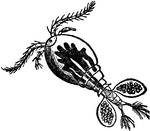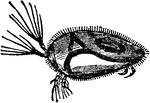Clipart tagged: ‘cypris’

Cypris
Cypris, a modern ostracod. Female before sexual maturity, right valve of shell removed to show internal…

Cyclops communis Water Flea
"Water Flea is a popular name for minute aquatic Crustaceans such as daphnia, cypris, and cyclops. In…

Cypris Unifasciata Water Flea
"Water Flea is a popular name for minute aquatic Crustaceans such as daphnia, cypris, and cyclops. In…

Daphnia Pulex Water Flea
"Water Flea is a popular name for minute aquatic Crustaceans such as daphnia, cypris, and cyclops. The…


